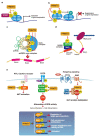The Role of PRMT5 in Immuno-Oncology
- PMID: 36980950
- PMCID: PMC10048035
- DOI: 10.3390/genes14030678
The Role of PRMT5 in Immuno-Oncology
Abstract
Immune checkpoint inhibitor (ICI) therapy has caused a paradigm shift in cancer therapeutic strategy. However, this therapy only benefits a subset of patients. The difference in responses to ICIs is believed to be dependent on cancer type and its tumor microenvironment (TME). The TME is favorable for cancer progression and metastasis and can also help cancer cells to evade immune attacks. To improve the response to ICIs, it is crucial to understand the mechanism of how the TME is maintained. Protein arginine methyltransferase 5 (PRMT5) di-methylates arginine residues in its substrates and has essential roles in the epigenetic regulation of gene expression, signal transduction, and the fidelity of mRNA splicing. Through these functions, PRMT5 can support cancer cell immune evasion. PRMT5 is necessary for regulatory T cell (Treg) functions and promotes cancer stemness and the epithelial-mesenchymal transition. Specific factors in the TME can help recruit Tregs, tumor-associated macrophages, and myeloid-derived suppressor cells into tumors. In addition, PRMT5 suppresses antigen presentation and the production of interferon and chemokines, which are necessary to recruit T cells into tumors. Overall, PRMT5 supports an immunosuppressive TME. Therefore, PRMT5 inhibition would help recover the immune cycle and enable the immune system-mediated elimination of cancer cells.
Keywords: PRMT5; immune checkpoint; immune evasion; immuno-oncology; tumor microenvironment.
Conflict of interest statement
The authors declare no conflict of interest.
Figures





References
Publication types
MeSH terms
Substances
LinkOut - more resources
Full Text Sources
Medical

